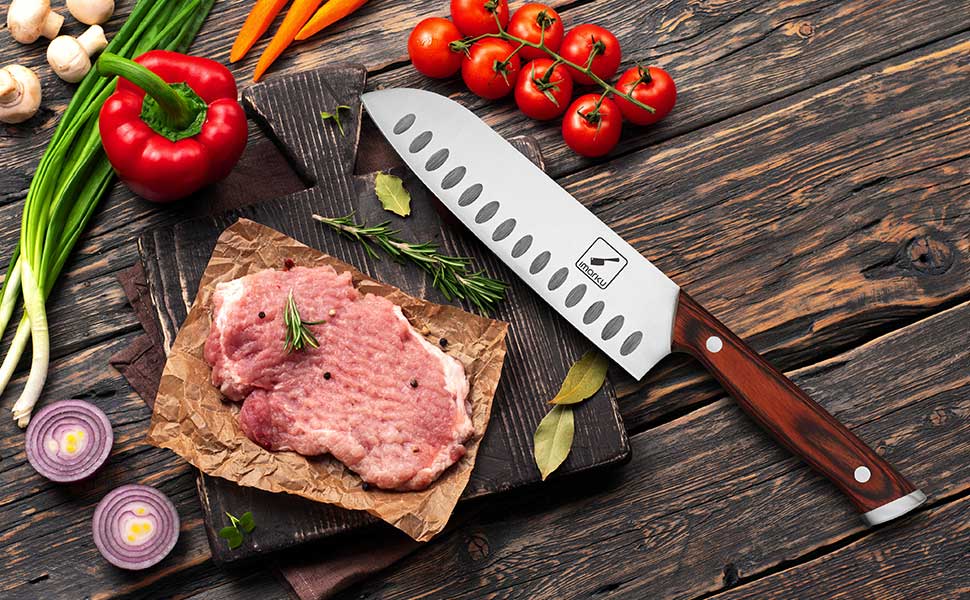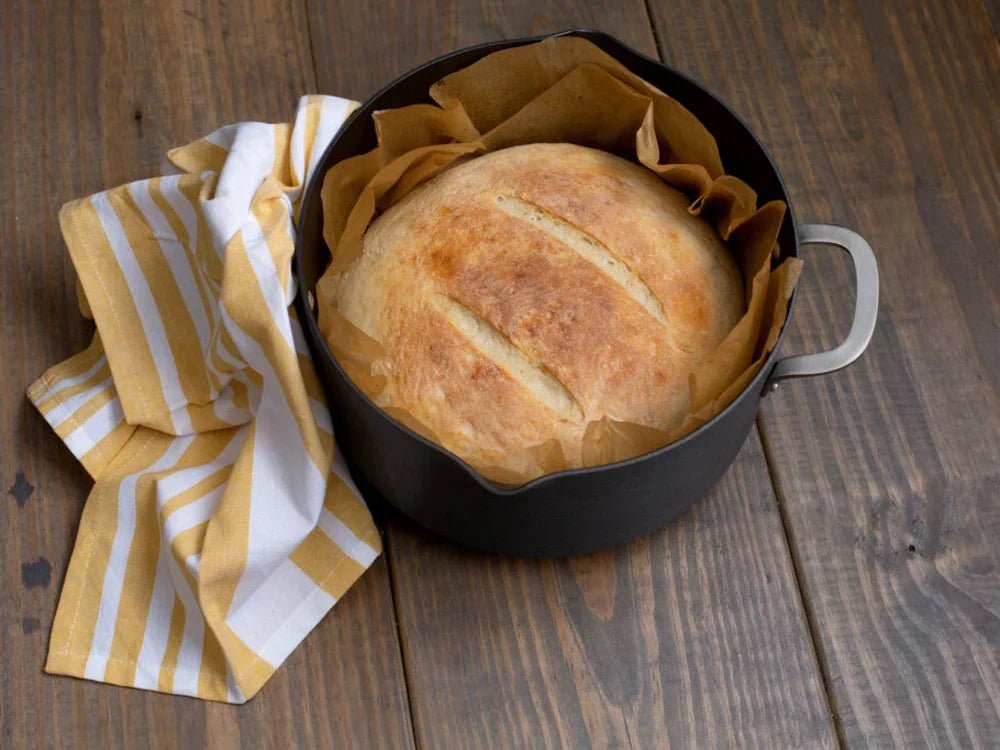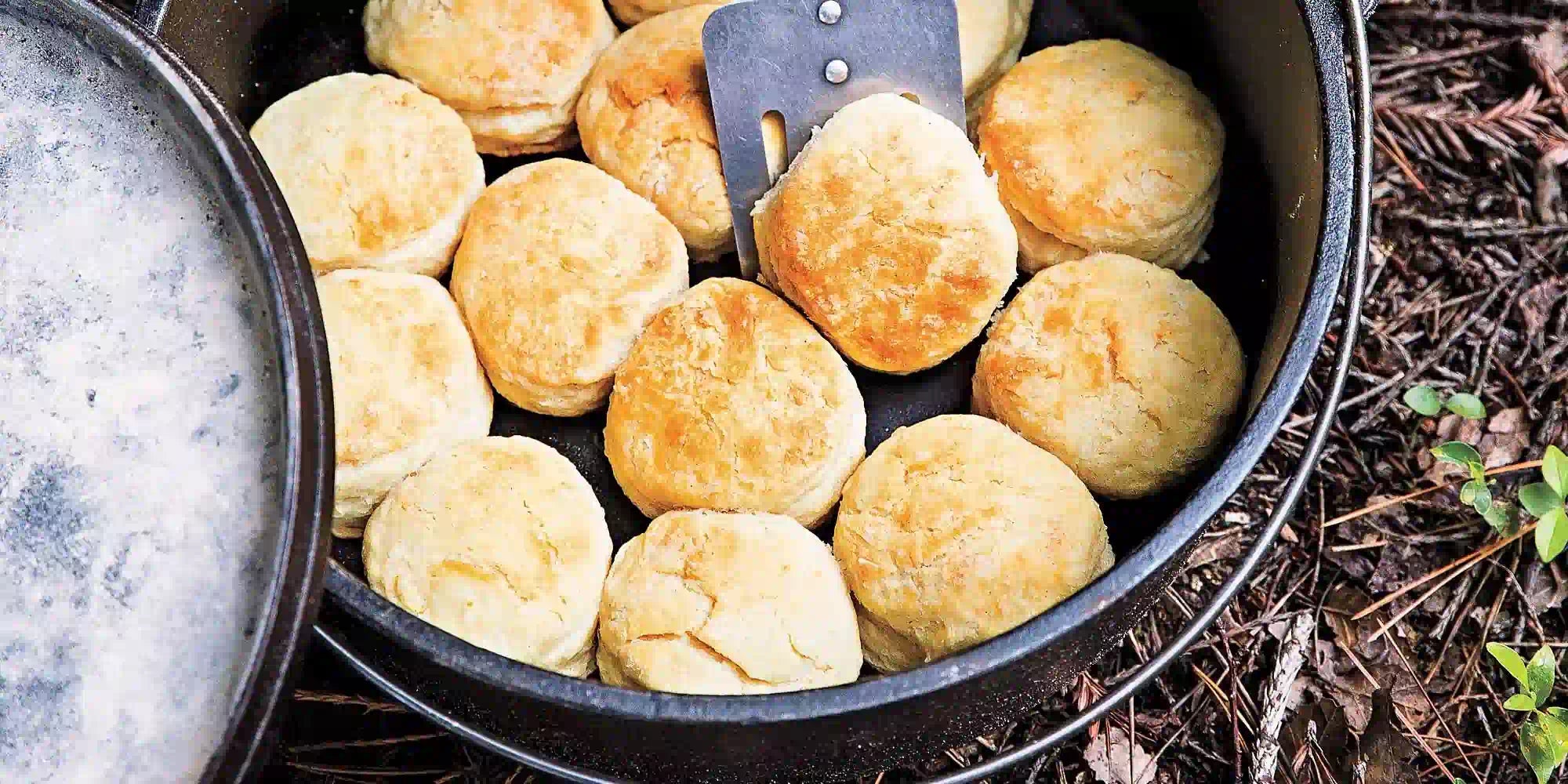TABLE OF CONTENTS
A Santoku knife is a relatively new Japanese chef's knife invented in the middle of the 20th century. Santoku knives are general-purpose kitchen knives that are good for cutting meat, fish, and vegetables. They are popular internationally.
Traditionally, Japanese chefs used a Gyuto knife to cut meat, a Deba knife for fish, and a Nakiri knife for vegetables. A Santoku knife is a multi-purpose knife that is good for cutting all three.
Since it can cut all three, it is known as a "three virtues" knife. A Santoku knife is also suitable for all three of cutting, slicing, and chopping. The term Santoku (three virtues) may refer to the knife's ability to cut, slice, and chop.
History
Japanese cutlery was distinct from western cutlery before the late 1800s, after which the Japanese adopted French and German cutlery designs. While Japanese knives became more similar to western knives in the late 1800s, there are still distinct Japanese styles.
Santoku knives appeared as world war two was ending. They were intended as an alternative to the earlier Japanese vegetable cleaver, the Nakiri. Compared to the Nakiri, the Santoku is easier to use, more general-purpose, and similar to a western chef's knife.
The Santoku was a very successful invention, and it quickly became the most famous chef's knife in Japan. Today, people use Santoku knives in many different countries. Both ordinary home cooks and professional cooks use Santoku knives all over the world.

Design
While Western chef's knives inspire santoku knives, they are not the same. The Santoku knife is a unique type that is not very similar to any earlier Japanese or western knife.
Like the Nakiri, the Santoku is a tall knife with a straight rather than curved blade. The way the top of the knife curves down towards the point is different for a Sankotu than for a Nakiri. The point of a Santoku knife is much gentler.
Compared to a western chef's knife, the Santoku is shorter, only 5 to 8 inches long, rather than 8 or 10 inches. A Santoku knife will keep its edge longer than a western knife but is harder to sharpen.
Santoku knives have straight rather than curved blades. This makes them worse for things like chopping chives or garlic than curved knives are. There are many tasks that you need something other than a Santoku knife for.
Because of its boxier build, the Santoku is not much lighter than a western chef's knife. The Santoku knife is also made of heavier steel, so it does not lack weight. The weight distribution is more balanced than a western knife's weight distribution is.
The relatively gentle "sheep's foot" blade has its advantages and disadvantages. You can chop more efficiently with a knife that does not have much point, and you won't accidentally pierce anything. On another level, it is not good if you need a knife with a sharp point.
Traditional Japanese knives use a "chisel bevel" or a blade that tapers to a point on one side and is straight on the other side. Western knives use a "double bevel" or a blade that tapers to a point on both sides. Some newer Japanese knives use an asymmetrical bevel that tapers at a different angle on each side.
Japanese steel is different from western steel, which gives the knives some advantages and disadvantages. Japanese steel is harder, which makes the edge last longer and requires less sharpening. On the downside, harder steel will chip more easily.
Other Japanese Cutlery
There are many Japanese kitchen knives and many Japanese variations on western knives. Some knives are very distinctive; others are only slight variations on their western counterparts.
A Gyutou (chef's knife) is very similar to a western chef's knife and is intended for preparing western food. They are good for as wide of a variety of tasks as western chef's knives are. They are lighter, thinner, and made of harder steel but are otherwise similar to western knives.
Japanese paring knives are similar to their western counterparts. These are small knives intended for delicate cutting. Many Japanese boning knives are very similar to western knives. There are also Hankotsu knives for cutting hanging meats and very different from western boning knives.
Sujihiki knives are similar to slicer knives in western countries. They are also thinner and made of harder steel. The bevel is sharpened at a steeper angle for more accurate cutting. Sujihiki knives are carving and filleting knives.
There are also Pankiri (bread knives), Deba (butcher knives), Nakiri (vegetable cleavers), and Takobiki (slicer knives), none of which are identical to any western knife.
What to Look for in a Great Santoku Knife
Any chef's knife, including any Santoku knife, should be very sharp when it is new. It would help if you never had to sharpen it at all before you use it. If the edge isn't excellent right from the start, it is a shoddy product.
The knife should also stay sharp for a long time. While you will inevitably have to get your knife sharpened or sharpen it yourself, the edge should last for a long time. Most home chefs don't get their knives sharpened often, and you shouldn't use a dull knife for long.
The knife should also be well-balanced and feel great in your hand. The width and height of the handle should match the weight of the blade. While different chefs will agree that a bad knife is poorly balanced, they won't all agree on what an excellent knife is. Other chefs have different favorites.
Santoku knives are supposed to be small and light. Get a different type of knife if you want something much bigger and heavier than the typical Santoku.
How to Test a Santoku Knife
One good way to test a kitchen knife's quality is the paper test. While almost any knife can cut paper, it takes a sharp knife to cut paper without tearing it. A decent knife can cut paper cleanly.
A knife is excellent if it can still cut paper cleanly after being used for quite a while without sharpening it. A high-quality Santoku knife doesn't need to be sharpened very often. It would help if you had to use it for quite a while before the knife fails any of these tests.
Some vegetables are harder for a knife to cut properly than others. Tomatoes are a good test of a knife's quality. A dull knife will crush a tomato; a sharp knife can cut through it without squishing it at all.
Another test is to cut carrots into thin sticks - you can't easily do that if your knife is dull. You can also cut meat and fish to test a knife's quality.
Try cutting up a whole chicken or filleting a fish to see how finely the knife can cut. Despite not having much of a point, a good Santoku knife should be able to do it. Some tasks are possible to do even if your knife is a bit dull. To test a knife's quality, try something more challenging that takes a sharp knife to do.
The Best Santoku Knife You can Buy
If you like to find any knive to stay sharp for a long time, the Imarku knives have distinctive features that make them stand out from the competition.
None of these knives are costly. You don't always have to buy expensive Sankotu knives to buy good ones. While some shoddy knives are on the market, you don't always have to spend much to buy quality. You can't always notice the difference between expensive and mid-priced Sankotu knives.
iMarku 5-Inch Sankotu Knife
This is my all-time favorite smaller Sankotu knife, maybe even my favorite knife of any kind. It is razor-sharp out of the box and doesn't need to be sharpened for a long time. You can depend on the Imarku 5-Inch Sankotu Knife for years.
One of the best things about the knife is that food won't stick to the blade's sides. It uses a unique anti-stick design that reduces cutting resistance as well as preventing food from sticking. That, on its own, makes the Imarku stand out from the competition. If you try it, you will immediately notice how much of a difference this feature makes.
You can use the Imarku 5-Inch for a long time without tiring out your wrist. The handle is well designed for the shape of the blade. It is more comfortable than any other knife I have tried. It might be the best Santoku knife you can buy.
iMarku 7-Inch Sankotu Knife
Knives from iMarku last for a long time. The iMarku 7-Inch Sankotu Knife is high-quality stainless steel that will not rust, corrode, or even discolor.
The high-quality metal also keeps the blade sharp for a long time. You won't have to sharpen the iMarku 7-Inch very often or get it professionally sharpened. It is capable of making a lot of intricate cuts that only a very sharp knife can make.
Like the iMarku 5-Inch, the 7-Inch uses a hollow-edge design to ensure space between the food and the knife's edge. This prevents food from sticking to the edge and is what makes the iMarku knives great purchases.
The handle is just the right size and shapes for a knife of this size. Even if you have hands size is small, the handle is just right. Since it is so ergonomically designed, you can cut for a long time without getting tired.























Leave a comment
All comments are moderated before being published.
This site is protected by hCaptcha and the hCaptcha Privacy Policy and Terms of Service apply.